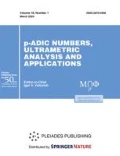Abstract
Considering the main aspects of a previous formal model of the relationships unconscious-conscious based on the representation of mental entities by m-adic numbers through hysteresis phenomenology, a pattern which has been then used to work out a possible psychoanalytic model of human consciousness as well as to argue on a simple derivations of p-adic Weber-Fechner laws of psychophysics, we now carry on along this formal analysis putting forward some remarks about the possible applications and consequences of this model of human psyche in regard to central themes of economics and sociology.
Similar content being viewed by others
References
R. Argenziano and I. Gilboa, “Psychophysical foundations of the Cobb-Douglas utility function,” Econom. Lett. 157, 21–23 (2017).
K. J. Arrow, Social Choice and Individual Values, 2nd edition (John Wiley & Sons, Inc., New York, USA, 1963).
D. Cargnello, Alterita e alienita (Feltrinelli Editore, Milano, 1977).
H. Carr, “An interpretation of the Weber-Fechner law,” Psycholog. Rev. 34 (4), 313–19 (1927).
V. Castronovo (a cura di), Nuovi equilibri in un mercato globale - Le sfide dell’Asia e le tempeste del turbocapitalismo finanziario (Editori Laterza/RCS Media Group, Roma-Bari/Milano, 2019).
A. C. Chiang, Fundamental Methods of Mathematical Economics (McGraw-Hill Book Company, New York, NY, USA, 1974).
J. S. Coleman, Foundations of Social Theory (Harvard University Press, Cambridge, MA, USA, 1990).
D. Cuche, La notion de culture dans les sciences sociales (Editions La Decouverte, Paris, 2010).
S. D’Onofrio, Levi-Strauss face р la catastrophe (Editions Mimesis, Paris, 2018).
B. Dragovich and D. Joksimovic, “On possible uses of p-adic analysis in econometrics,”, Megatrend Rev. 4 (2), 5–16 (2007).
B. Dragovich, A. Yu. Khrennikov, S. V. Kozyrev, I. V. Volovich and E. I. Zelenov, “p-Adic mathematical physics: the first 30 years,” p-Adic mathematical physics: the first 30 years 9 (2), 87–121 (2017).
C. Ferrauto, Esercizi di statistica (G. Giappichelli Editore, Torino, IT, 1996).
E. Fromm, The Sane Society (Rinehart & Company, Inc., New York, USA, 1955).
E. Fromm, To Have or To Be? (Harper & Row Publishers, Inc., New York, 1976).
G. Iurato and A. Yu. Khrennikov, “Hysteresis model of unconscious-conscious interconnection: exploring dynamics on m-adic trees,” p-Adic Numbers Ultramet. Anal. Appl. 7 (4), 312–321 (2015).
G. Iurato, A.Yu. Khrennikov and F Murtagh, “Formal foundations for the origins of human consciousness,” p-Adic Numbers Ultramet. Anal. Appl. 8 (4), 249–279 (2016).
G. Iurato, “A possiblep-adic Weber-Fechner law,” p-Adic Numbers Ultramet. Anal. Appl. 10 (4), 299–304 (2018).
K. K. Solms and M. Solms, Clinical Studies in Neuro-Psychoanalysis. Introduction to a Depth Neuropsychology (Routledge, London, UK, 2001).
A. Yu. Khrennikov, Non-Archimedean Analysis: Quantum Paradoxes, Dynamical Systems and Biological Models (Kluwer Academic Publishers, Dordrecht, ND, 1997).
A. Yu. Khrennikov, Classical and Quantum Mental Models and Freud’s Theory of Unconscious Mind (Vaxjö University Press, Vaxjo, Sweden, 2002).
D. H. Krantz, “Integration of just-noticeable differences,” J. Math. Psychol. 8 (4), 591–99 (1971).
J. Laplanche and J-B. Pontalis, The Language of Psycho-Analysis (W. W. Norton & Company, Inc., New York, NY, USA, 1974).
J. Laplanche, Problematiques VII: Le fourvoiement biologisant de la sexualite chez Freud. Biologisme et biologie (PUF-Presses Universitaires de France, Paris, 2006).
F. Leukel, Introduction to Physiological Psychology, 3rd edition (C.V. Mosby Publishing Company, Saint Louis, MO, USA, 1976).
C. Levi-Strauss, Tristes Tropiques (Librairie Plon, Paris, 1955).
R. Luccio, La psicologia: un profilo storico, con la collaborazione di S. Gori Savellini (Editori Laterza, Roma-Bari, IT, 2000).
Yu. I. Manin, “Continuo/discreto”, in Enciclopedia Einaudi, Vol. 3, pp. 935–986 (Giulio Einaudi editore, Torino, IT, 1978).
V. Matera and A. Biscaldi, Manuale di scienze umane. Sociologia (De Agostini Scuola/Marietti Editore, Novara, IT, 2012).
J. McCall, “Viconomics: an evolutionary science of mind and society,” Viconomics: an evolutionary science of mind and society Part II, Ch. 7, pp. 91–130 (MacMillan Press, London, UK, 1996).
S. Nolen-Hoeksema, B. L. Fredrickson, G. R. Loftus and C. Lutz, Atkinson & Hilgard’s Introduction to Psychology, 16th edition (Cengage Learning EMEA Publishing, Ltd., Boston, MA, USA, 2014).
J. H. Ospina-Holguin, “The Cobb-Douglas function for a continuum model,” Cuadernos de Economía 36 (70), 1–18 (2017).
E. Pewzner and J-F. Braunstein, Storia della psicologia (Giulio Einaudi editore, Torino, IT, 2001).
F. Poma, Corso di economia politica (Edizioni Principato, Messina, IT, 1980).
E. M. Purcell, Electricity and Magnetism. Berkeley Physics Course, Vol. 2 (McGraw-Hill Book Company, New York, USA, 1965).
G. C. Quarton, T. Melnechuk and F. O. Schmitt, Eds., The Neurosciences. A Study Program (Rockefeller University Press, New York, NY, USA, 1967).
P. J. Reis Mourao, “The Weber-Fechner law and public expenditures impact to the Win-Margins at parliamentary elections,” Prague Econom. Papers 3, 291–308 (2012).
J. Rifkin, Entropy. Into the Greenhouse World, 2nd revised and updated edition with the collaboration of Ted Howard, Foundation of Economic Trend (Penguin Putnam, Inc., New York, NY, 1989).
P. A. Samuelson and W. D. Nordhaus, Economics (McGraw-Hill Book Company, New York, NY, USA, 1995).
K. Shigemoto, “Weber-Fechner’s law and Cobb-Douglas function,” Tezukayama Econom. Papers 6, 69–73 (1997).
K. Shigemoto, “Weber-Fechner’s law and Demand function,” Tezukayama Econom. Papers 6, 41–46 (2002).
K. Shigemoto, “Weber-Fechner’s law, Demand function and related topics,” Tezukayama J. Busin. Econom. 15, 51–56 (2005).
S. S. Stevens, “On the theory of scales of measurement,” Science 103 (2684), 677–680 (1946).
P. Teitelbaum, Psicologia jisiologica (Aldo Martello Editore, Milano, IT, 1971).
F. Teulon, Introduction à l’économie (PUF-Presses Universitaires de France, Paris, 1992).
H. R. Varian, Intermediate Microeconomics. A Modern Approach (WW Norton & Company, Inc., New York, NY, USA, 1999).
M. Weber, “Marginal utility theory and the fundamental law of psychophysics,” Social Sci. Quart. 56 (1), 21–36 (1975).
M. Zafirovski, “Max Weber’s analysis of marginal utility theory and psychology revisited: latent propositions in economic sociology and the sociology of economics,” History Polit. Econom. 33 (3), 437–458 (2001).
Author information
Authors and Affiliations
Corresponding author
Additional information
The text was submitted by the author in English.
Rights and permissions
About this article
Cite this article
Iurato, G. Hysteresis, Unconscious and Economics. P-Adic Num Ultrametr Anal Appl 11, 270–279 (2019). https://doi.org/10.1134/S2070046619040022
Received:
Revised:
Accepted:
Published:
Issue Date:
DOI: https://doi.org/10.1134/S2070046619040022


